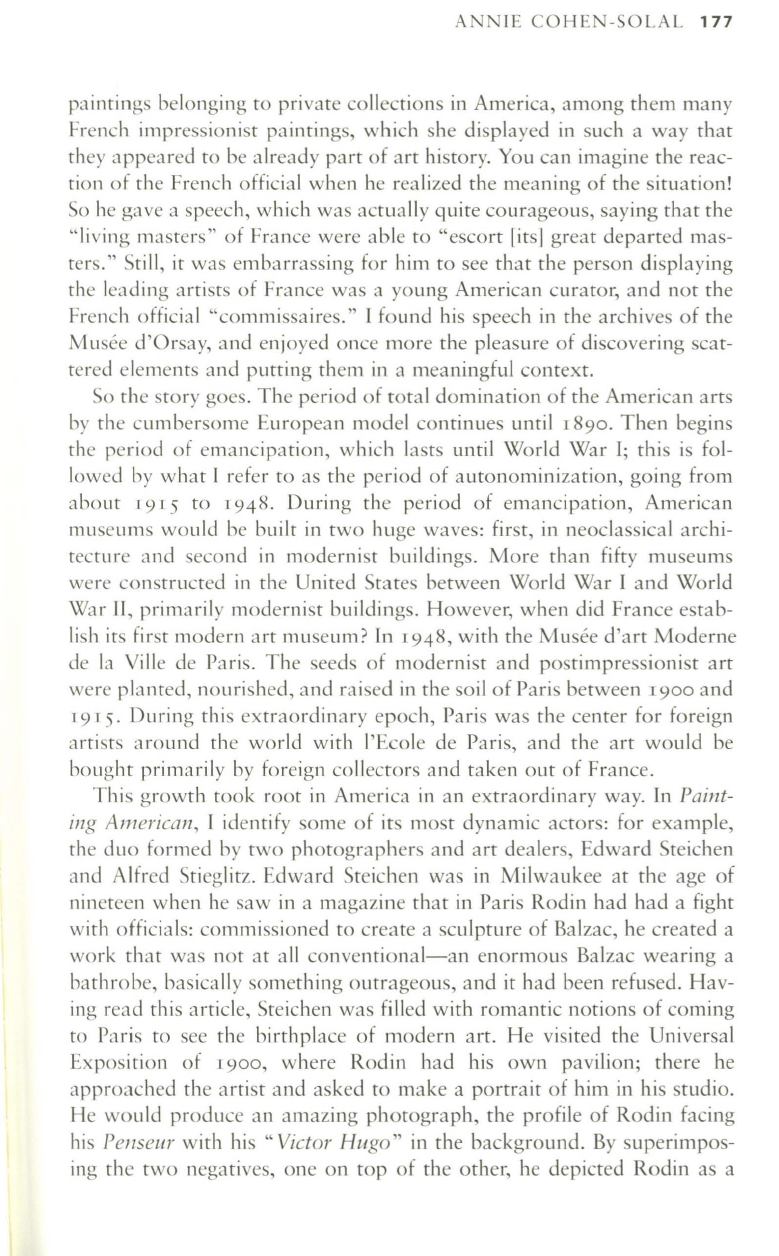
ANNIE COHEN-SOLAL
177
paintings belonging to private collections in America, among them many
French impressionist paintings, which she displayed in such a way that
they appeared to be already part of art history. You can imagine the reac–
tion of the French official when he realized the meaning of the situation!
So he gave a speech, which was actually quite courageous, saying that the
"living masters" of France were able to "escort litsl great departed mas–
ters." Still, it was embarrassing for him to see that the person displaying
the leading artists of France was a young American curatol; and not the
French official "commissaires." [ found his speech in the archives of the
Musee d'Orsay, and enjoyed once more the pleasure of discovering scat–
tered elements and putting them in a meaningful context.
So the story goes. The period of total domination of the American arts
by the cumbersome European model continues until
1890.
Then begins
the period of emancipation, which lasts until World War I; this is fol–
lowed by what I refer to as the period of autonominization, going from
about
1915
to
1948.
During the period of emancipation, American
museums would be built in two huge waves: first, in neoclassical archi–
tecture and second in modernist buildings. More than fifty museums
were constructed in the United States between World War I and World
War II, primarily modernist buildings. However, when did France estab–
lish its first modern art museum? In
1948,
with the Musee d'art Moderne
de la Ville de Paris. The seeds of modernist and postimpressionist art
were planted, nourished, and raised in the soil of Paris between
1900
and
1915.
During this extraordinary epoch, Paris was the center for foreign
artists around the world with l'Ecole de Paris, and the art would be
bought primarily by foreign collectors and taken out of France.
This growth took root in America in an extraordinary way. In
Paint–
ing American,
I identify some of its most dynamic actors: for example,
the duo formed by two photographers and art dealers, Edward Steichen
and Alfred Stieglitz. Edward Steichen was in Milwaukee at the age of
nineteen when he saw in a magazine that in Paris Rodin had had a fight
with officials: commissioned to create a sculpture of Balzac, he created a
work that was not at all conventional-an enormous Balzac wearing a
bathrobe, basically something outrageous, and it had been refused. Hav–
ing read this article, Steichen was filled with romantic notions of coming
to Paris to see the birthplace of modern art. He visited the Universal
Exposition of
1900,
where Rodin had his own pavilion; there he
approached the artist and asked to make a portrait of him in his studio.
He would produce an amazing photograph, the profile of Rodin facing
his
Pel1Sellr
with his"
Victor Hugo"
in the background. By superimpos–
ing the two negatives, one on top of the other, he depicted Rodin as a


